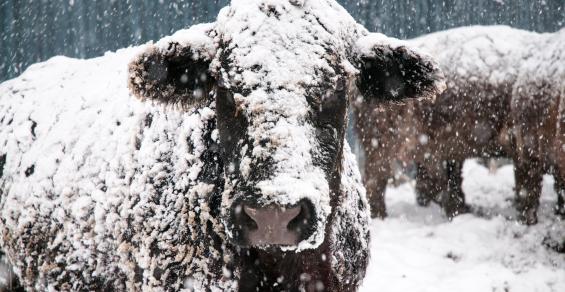In early January, Nebraska and other parts of the Midwest and Great Plains experienced extreme lows when temperatures dipped into the sub-zeros – in some cases in northern Nebraska, with wind chill factored in, temperatures reached as low as -40.
With temperatures this low, some may be wondering: is there an impact on cattle health? However, it’s worth keeping in mind that cattle are resilient – especially those, like many in Nebraska, that are adapted to the extreme climate of the northern Plains.
And while cold temperatures may be a concern for some, Terry Mader, retired University of Nebraska-Lincoln animal science professor and private veterinary consultant, notes most cattle in Nebraska adapt to cold weather without issues.
“I think the highs within a 5-to-7 day period went from somewhere in 30s to 40s down to the teens, and then down to zero and sub-zero temperatures. Cattle can adapt to about a 5-to-10 degree temperature change easily over about a month period, but when you have that change over a week, it is more stressful,” says Mader. “That being said, mature animals and animals on feed that are receiving a balanced diet with enough energy will handle that fairly well. Young animals and animals on maintenance diets tend to be compromised the most.”
This includes young calves, and lactating cows and heifers. Research on the northern Plains has reported up to a 4% increase in calf morbidity and 2% increase in calf mortality for late-winter calving compared with early spring or late spring calving. While most in Nebraska don’t calve this early, there are still newborn calves on the ground in early spring – at a time when peak nutritional demand for lactating females corresponds with low forage availability, and when extreme weather conditions are still a possibility.
However, many producers in western Nebraska have pushed calving back to late spring or even early summer, avoiding calving in extreme conditions and shifting peak nutritional demands for pregnant cows and heifers. Rick Funston, Nebraska Extension beef reproductive physiologist, notes managing the calving season to follow spring green-up allows cows and heifers to have an increasing plane of nutrition that corresponds with increases in nutritional requirements.
“Calving in early March and April, you’re ahead of grass, so you’ve got to feed cattle. Nutrient requirements are higher,” Funston says. “When you’re calving later, you’re avoiding extreme temperatures, you’re moving more into lactation when cows are grazing higher-quality forage, so the need for supplementation is decreased. In some of our early work at the Gudmundsen Sandhills Laboratory, we took all the harvested forage out of the later calving system. They’re in gestation when their nutrient requirements are less than during lactation.”
It’s worth noting that extreme cold weather and blizzards can occur in Nebraska well into spring. “It’s a very real risk,” says Funston. “Just from working with producers we see major snow events clear into May in some cases.”
“Producers manage on averages. If they’re going to calve early, they have to have some backup contingency plan if they manage, if they have vulnerable cattle like young calves,” adds Funston. “Most big ranches in Nebraska do not have labor and facilities to calve early on, so they’ve moved away from that risk. As we move into later spring, the chances of those events obviously decrease. We can have years with open winter, normal temperatures, no major events at all. Then we can calve essentially anytime. It’s about how much risk people are willing to accept.”
In the 1990s, then Nebraska Extension beef reproductive physiologist Gene Deutscher researched the potential impacts of cold winter weather on the birth weights of spring-born calves.
The study, which took place over six years at the West Central Research and Extension Center (WCREC) near North Platte, showed a negative correlation between average winter temperatures and spring calf birth weights – as average temperatures decreased, birth weights the following spring increased. However, Rick Funston, Extension beef reproductive physiologist, notes it’s hard to say whether there was an effect on calving difficulty.
“The implication was a colder winter produced bigger calves. In theory, part of that was due to nutrient uptake, blood flow, those types of things. Having said that, I’m not sure there was any conclusive evidence that dystocia was different. Birth weights were affected, but calving difficulty wasn’t,” Funston says. “There is anecdotal evidence that colder winters produce bigger calves, but it’s hard to study and quantify – it’s hard to simulate two different environments during the same gestation period, and if it’s true, there isn’t much you could do about it.”




Leave A Comment